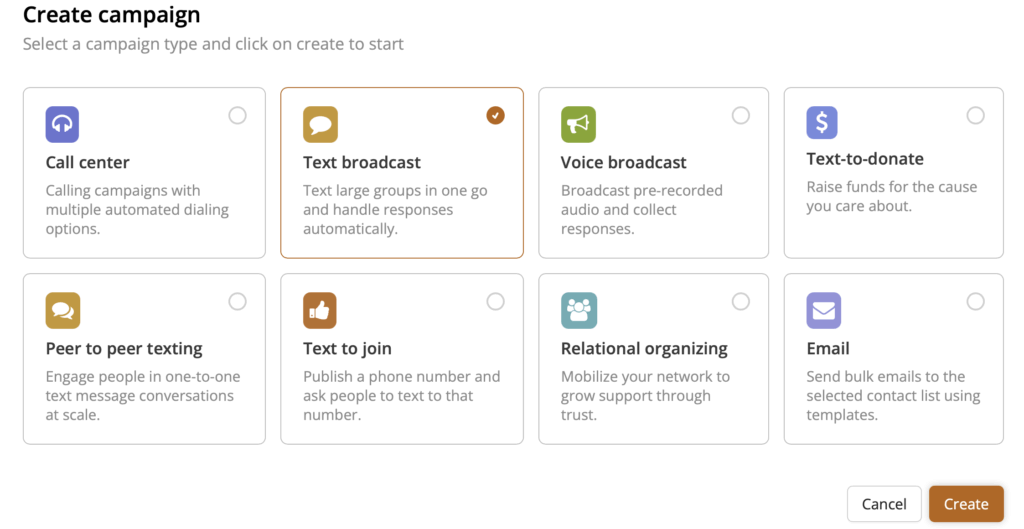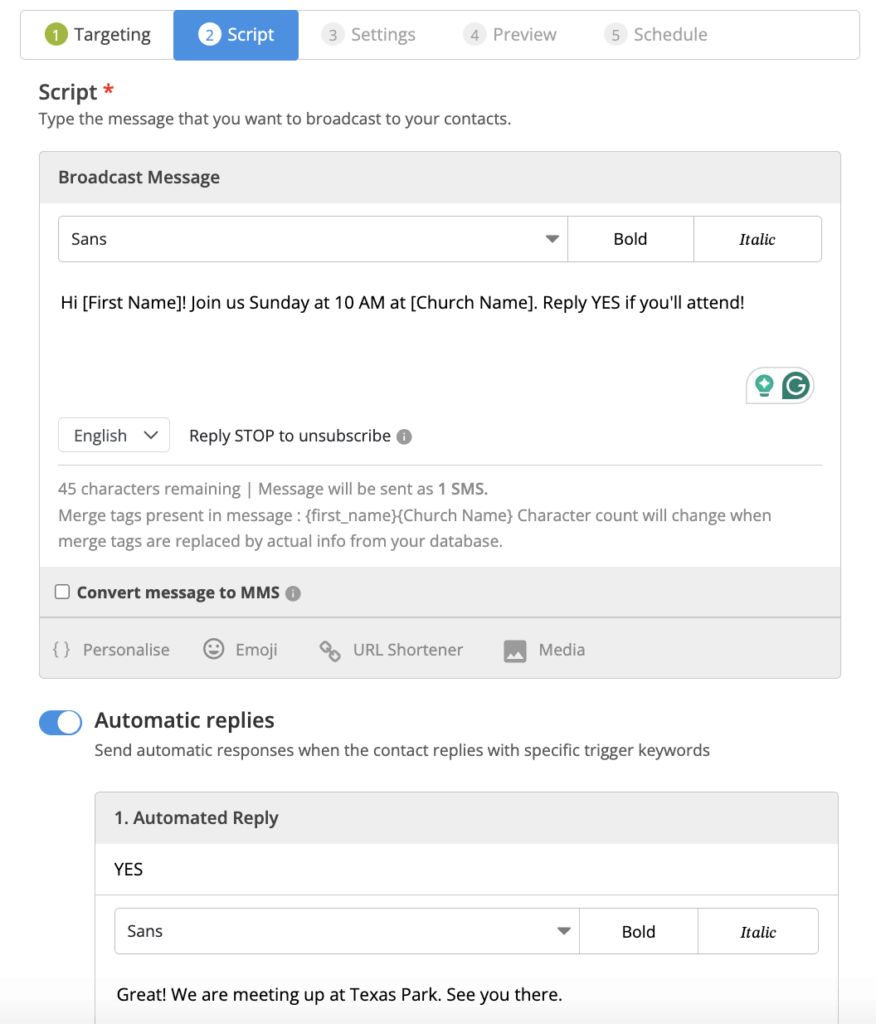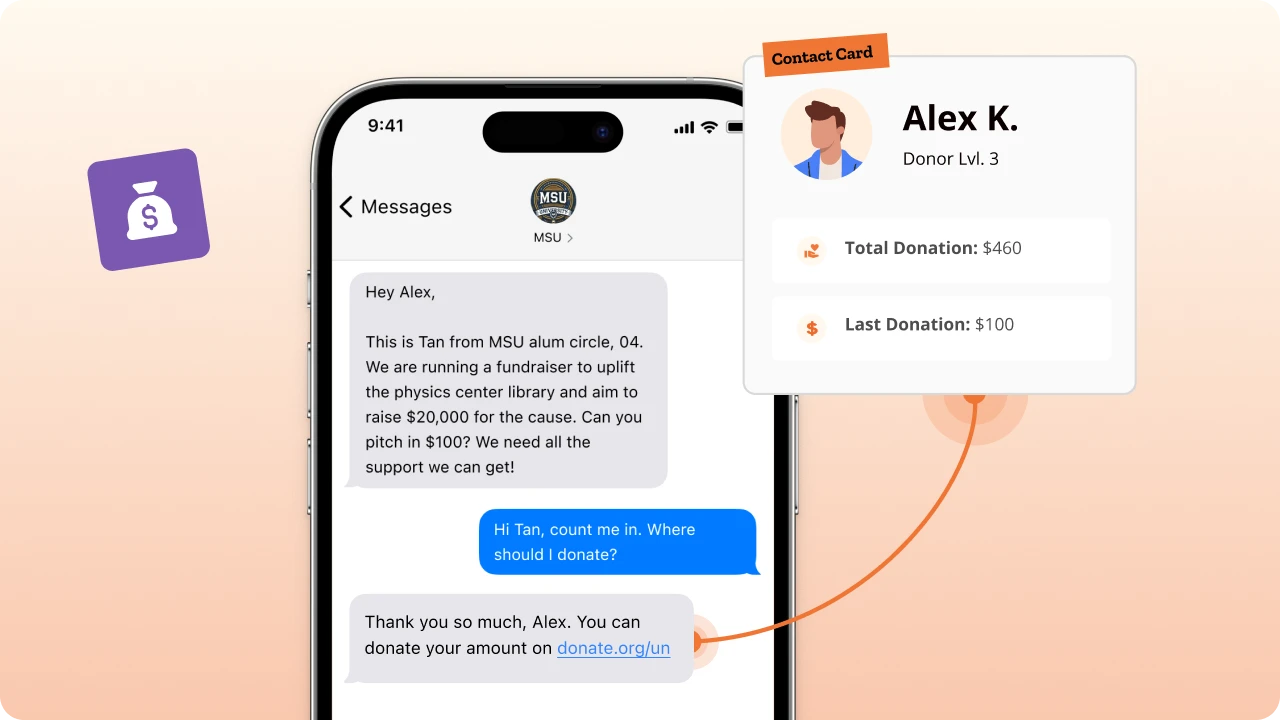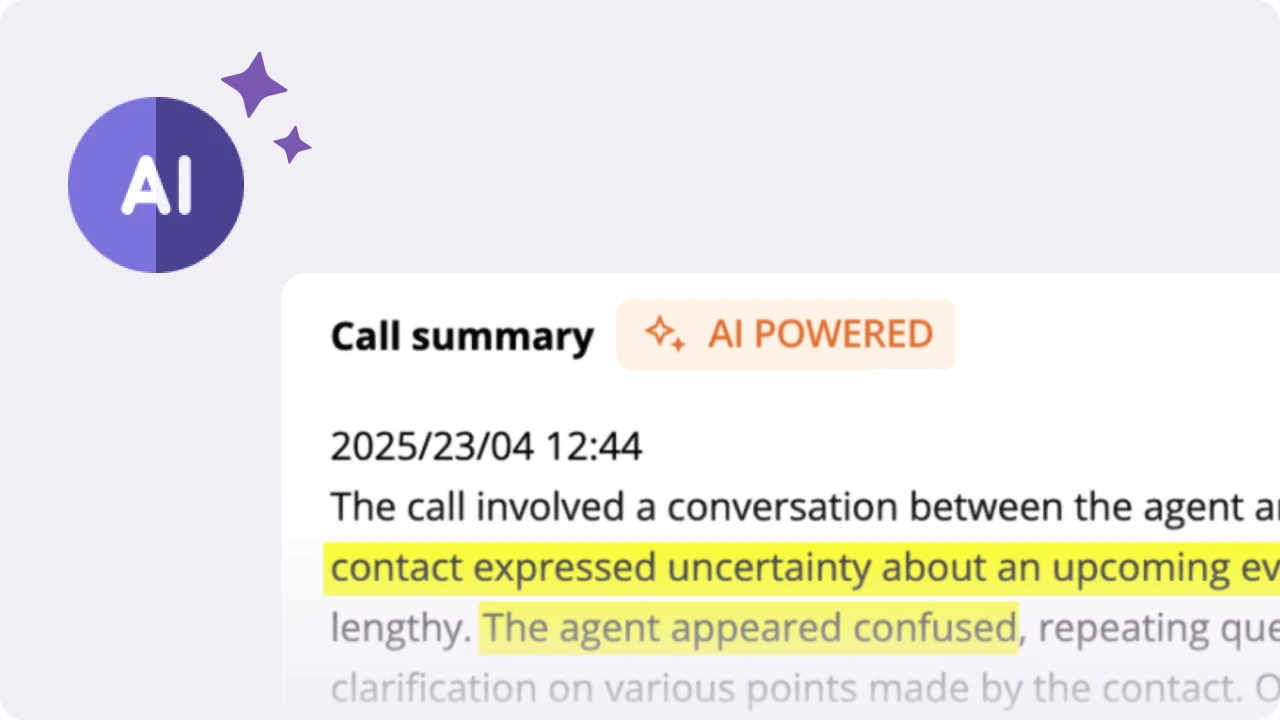Table of Contents
Church texting services are a communication platform that allows churches to send mass or peer-to-peer text messages directly to their congregation. This service helps facilitate:
- Real-time updates
- Event reminders
- Prayer requests
- Announcements and more
By leveraging text messaging, churches can foster a stronger connection with their members, ensuring that everyone stays informed and engaged.
In this blog, we’ll explore some of the top platforms and provide a detailed guide on how churches can maximize the benefits of text messaging to enhance engagement, streamline communication, and support their communities.
How do church texting services work?
Church texting services enable churches to send a text to their congregation with the push of a button.
There are usually two options to send texts:
- Mass texting service for churches – where you can send a text blast to all the members on your list. This usually helps you send thousands of texts at once.
- Peer-to-peer texting service for churches – where your church can have a personal one-to-one conversation with each member, and ask them for their input.
The easiest (and most popular) is the mass texting service for churches, with 40% of churches using it to keep their congregation updated about their latest events.

However, using only mass text messaging for churches can still leave a gap in your communication.
A bulk text does not enable back-and-forth communication with your members. Nor does it allow you to collect feedback from your members to identify areas for improvement.
In short, it makes your congregation feel uninvolved in the church’s proceedings. This is why using a combination of peer-to-peer church texting services and mass texting can yield better results.
Use cases for church texting services: Mass texting
1. Automate emergency responses using bulk SMS
Use mass texting to quickly reach all members during urgent situations like:
- Weather alerts
- Sudden schedule changes
- Emergency fund drives
- Last-minute cancellations

2. Increase attendance with reminders & notifications
Church attendance in the U.S. has been steadily declining over the years. Around 42% of adults attended church regularly between 2000–2003. This dropped to 38% and further fell to 30% in 2021–2023. A simple yet effective way to boost dwindling sermon attendance is by sending a bulk text message to your entire congregation about upcoming events.
Keep in mind that these texts should complement, not replace, your in-person announcements. Ideally, your members should have already heard about the event during church texting services or through bulletin boards. The text message serves as a timely reminder that encourages participation.
You can also use church texting services to keep your congregation updated about any schedule changes or new event details. Automated reminders for:
- Worship timings
- Youth programs
- Special holiday events
This ensures that your members stay connected, informed, and engaged.
Alt text: church-texting-services-reminders
3. Keep up with your congregation with ‘every-day’ texts
Using a mass text messaging service, you can send your congregation a scripture for the day or a thought for the day.

Such simple yet consistent communication will help them feel a sense of belonging to your church and encourage them to watch out for the texts you send.
Use cases for church texting services: Peer-to-peer texting
1. Shortcodes and keywords for opt-ins
There has been a drastic decline in church membership over the years.

A simple way to address this problem would be to enable memberships via a channel that appeals to the upcoming audience using– opt-in text messages.
You can advertise a keyword and a shortcode that interested parties can text in to learn more about your church. Here is how it can go:

Alice gets automatically added to the text messaging roster. She can be sent more information on how to join the congregation and participate in upcoming events.
Notice how Alice is sent an automated response requesting more information. Although this is a bulk text, the details collected can be automatically stored in your church management software for future use.
2. Keeping members involved with follow-ups
One of the biggest challenges for church communication is staying in touch with every member of the congregation. After a sermon, it’s often difficult to personally connect with everyone who attended.
With church texting services, you can send peer-to-peer follow-up texts to individual members and engage in one-on-one conversations. This approach helps members feel valued and encourages ongoing participation in church activities.

3. Simplify fundraising by collecting tithes via texts
Text-to-donate is a powerful way for churches to collect tithes and donations directly from their congregation. With this method, members can give in just a few taps, making it easy and convenient to support church initiatives.
There are two common approaches:
- Send a donation link via text: Members click the link and complete their donation online.
- Allow members to text their donation amount: Members can simply reply with the amount they wish to give, and the system processes it accordingly.

Text-to-donate works well for:
- Regular tithes
- Special campaigns
- Even ticketed fundraising events.
Responses can be handled automatically with a follow-up text via peer-to-peer texting for a more personal touch.
By leveraging text-to-donate, churches can simplify fundraising, increase participation, and make giving easier for their congregation—all directly from their phones.
CallHub’s text-to-donate services , for example, help church fundraising by:
- Making regular tithes easy and providing full-funnel visibility—track who received messages, clicked links, donated, and monitor new vs. returning donors.
- Capturing impulse donations in real time during live sermon events, allowing members to give instantly.
- Automatically syncing donations with the existing fundraising stack to keep records accurate and track recurring tithes.
4. Enhance communication with RCS messaging
RCS (Rich Communication Services) makes text messaging more engaging by allowing images, videos, quick-reply buttons, and interactive content.
Use cases include:
- Welcoming new congregants with a rich message featuring a welcome video, service timings, and links to ministries or volunteer opportunities.
- Promoting church events with interactive posters, RSVP buttons, and calendar add-ons.
- Sharing sermon highlights or community updates using images, videos, and quick-reply options for feedback or donations.

RCS adds a richer, more interactive layer to peer-to-peer texting while keeping communication personal.
5. Increase engagement through text surveys or feedback
One way to increase your congregation’s involvement in your church’s activities is to proactively reach out to them and solicit their feedback.
After major events, send short surveys asking for feedback using any church texting services to improve future events.
It helps the church stay in tune with the needs and preferences of its members.

6. One-to-one pastor chat via peer-to-peer texting
Many church websites now feature online chat, allowing visitors to directly connect with a pastor and discuss their concerns.
If your church does not offer that option, an easy way to enable it is by using peer-to-peer texting to initiate the conversation.
Instead of going to your website, members can send you a text with the keyword (e.g. HOPE). You can then start a peer to peer conversation with the member via SMS and listen to their problems. For instance, here is an example of a pastor chat that asks the visitor for more information:

Best practices for church text messaging
As with any channel of communication, church texting services also have certain best practices that can help you get more responses and better engagement from your congregation.
- Include your name and your church’s name: This helps the recipient form a human connection and also immediately understand who is texting them.
- Make it easy to opt out: Ensure that every text contains information on how to opt-out of text message communication with your church. It’s a better way to give your members the choice of receiving your texts and keep your lists up to date.
- Send texts at the right time: Pick a time when your audience would be most receptive to text messages (meaning when they are most likely to read it) and send texts only then. Ensure that this timing is consistent across days so that your members look forward to texts. CallHub provides the feature to schedule your texts as per your audience timezone

- Add a call to action: If your message is important enough to be sent via text, it would be prudent to see how your audience responds to it. Adding a CTA can help you there. E.g.. they can respond with more details, choose to respond Y or N, or simply click a link to make a donation.
Top 5 best church texting services
| Platform | Features | Rating | Pricing |
| CallHub | – Mass texting- Peer-to-peer texting- RCS- Text-to-donate- CRM integrations- Call broadcasting | 4.8/5 | $0.034 per SMS sent. Bulk discounts available for higher volumes |
| Clearstream | – Keyword-based opt-ins- Automated responses- Group messaging- Integrations with Planning Center and other tools | 4.8/5 | Starts at $29/month; free for church plants (new churches less than a year old) |
| Flocknote | – Email and SMS messaging- Group management- Event tracking- Member directory- Online giving integration | 4.6/5 | $75/month for Complete plan; additional costs based on member count |
| PastorsLine | – Bulk text and voice messaging- Multimedia support- Automated campaigns- Planning Center integration- Live polls | 3.1/5 | Pricing varies; check Pastor’s Line website for details |
| Tithe.ly | – Text-to-give- Email marketing- Church management tools- Drag-and-drop email editor | 4.6/5 | $19/month; additional texts at $10 per 500 |
How to set up church texting services with CallHub?
Church texting services are remarkably easy to set up. CallHub is no exception – you can get started in just 4 simple steps.
- Select the campaign you are interested in (usually, it is SMS broadcast for mass texting)

Pick a campaign name, campaign type, and add the contact list (the list of members you want to reach)

Craft a message and an automatic reply. This is what would be sent to your audience.

Add the number of attempts to retry failed messages, the time between each message, and schedule it.

And you are done! It is as simple as that.
What was outlined above is a rather straightforward use case where you send a mass text message.
However, as we discussed, most of your texts should align with a broader communication strategy.
That is, instead of randomly sending texts, they should have a goal behind them, like:
- Increase attendance
- Raise more funds
- Improve engagement, etc.
With that in mind, here is a more detailed approach to setting up text messaging in your church ministry, designed to streamline your communication efforts.
Let us suppose that your annual church fundraising event is approaching. You want to use SMS to increase attendance and, in turn, raise more funds for your church. Here is an example of how to go about it.
- Step 1. Send out a bulk SMS to all the members of your congregation. In that, briefly outline the proposed event and call for volunteers. Interested members can text back to the same message, with the keyword ‘Volunteer’.
- Step 2. Contact each sign-up via peer-to-peer texts to determine exactly how they would like to be involved.
Eg. “Hi Jane, thanks for signing up to be a volunteer. Would you like to help with the organizing committee or the creative team?“
- Step 3. Based on their responses, assign them to a team, segment their contacts in your contact list, and send out bulk SMS with relevant texts to each group.
- Step 4. Send updates via bulk SMS to your congregation about the progress to keep them informed and involved.
- Step 5. Send reminders and notifications to the guests (attendees) about the upcoming fundraising event.
- Step 6. After the event, remember to send an SMS survey to all attendees and volunteers to gather their feedback and identify areas for improvement. This will provide you with valuable insights on how to maximize your next events.
These 6 steps can be tailored for volunteer recruitment, encouraging guests to become members at your church, and making new members feel more welcome and involved.
How churches can make the most of church texting services
Keeping your congregation connected has never been easier. With a church texting service, you can send quick updates, reminders, and messages that help members stay involved, plan for events, give donations, or even have one-on-one chats with pastors. You can also gather feedback through surveys or polls to see what’s working and where you can improve—all in a simple, organized way. Here are some key features to look for in a texting platform:
- Bulk SMS & peer-to-peer messaging
- RCS messaging
- URL shortener
- 10DLC (10-Digit Long Code) and Shortcodes
- Automatic replies
- Profanity filter
- Integrations
- Scheduling & campaign management
- Analytics & reporting
CallHub combines all these features into one easy-to-use platform. Use CallHub to make communication with your congregation smooth, personal, and effective—keeping members engaged, boosting attendance, collecting valuable feedback, and strengthening your church community.
FAQs on church texting services
1. Is there a free church texting service?
Yes, there is. Some platforms, such as PastorsLine and Tithe.ly, offer a free trial or limited free services. It’s essential to evaluate the features and limitations before committing.
2. What is the best texting platform for churches?
The best platform depends on your church’s specific needs, such as the size of the congregation, desired features, and budget. Platforms like CallHub and Clearstream are popular choices.
3. Which is the best mass texting service?
CallHub is recognized for its robust mass texting capabilities, including automation, peer-to-peer texting, integrations, RCS, MMS, and numerous other features.


